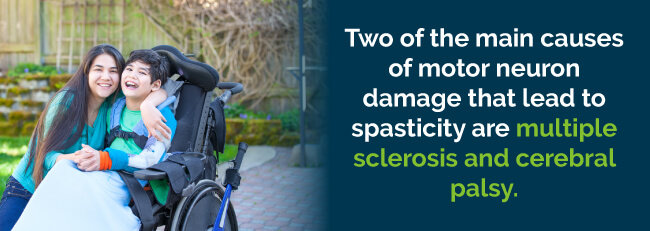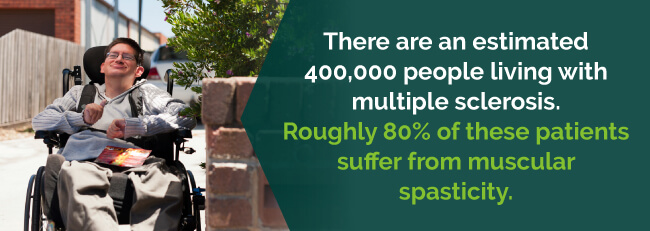
Medical marijuana has proven to be an effective alternative treatment for many conditions, from Alzheimer’s to Crohn’s disease. However, it’s also showing to be a promising natural treatment for other rare and chronic conditions. One of these conditions is intractable skeletal muscular spasticity.
With rare and chronic conditions like skeletal muscular spasticity, patients don’t have the same number of treatment options as they might with more common conditions that have been better researched. At this time, the conventional treatment options are limited to benzodiazepines (anti-anxiety medications) and surgical procedures.
Because spasticity is a condition that patients must manage on an ongoing basis, many people who suffer from this condition are looking for safe, alternative therapies to take regularly without harmful side effects. Thankfully, ongoing research indicates there may be a strong connection between medical marijuana and intractable skeletal muscular spasticity symptoms in many patients.
Intractable skeletal muscular spasticity is a rare condition that causes a person’s muscles to be continuously contracted. Contracted muscles cause a feeling of stiffness or tightness, which makes it difficult to use those muscles. Contracted muscles also lead to increased incidents of muscle spasms or exaggerated jerk reflex reactions, which are all involuntary.
Intractable skeletal muscular spasticity is a condition that develops as the result of some other type of primary condition that affects the central nervous system, like multiple sclerosis or cerebral palsy. These conditions cause damage to motor neurons, which are responsible for muscle movement and contraction. Because spasticity is caused by damage from another injury or disease, muscular spasticity is usually considered a “sequela” condition, meaning it’s a complication from a previous condition.

Muscular spasticity affects an estimated 12 million people worldwide. While muscular spasticity mostly affects adults, it can also affect children with cerebral palsy or brain injuries. Spasticity is much more difficult to treat in children, as many conventional medicines are not approved for children.
The word “intractable,” in medical terms, means to be unstoppable. Therefore, the symptoms of intractable skeletal muscular spasticity cannot be stopped, but instead must be managed long-term. It’s a condition that can affect a patient’s ability to walk, move and even talk, as well as perform regular daily activities.
By managing symptoms, patients can help prevent a decline in their quality of life by controlling pain and maintaining mobility.
How doctors understand, define and treat muscular spasticity has progressed significantly over the past several decades. Even so, the medical community still doesn’t fully understand muscular spasticity.
Before 1980, spasticity was referred to as “upper motor neuron syndrome” or UMNS. These two terms were often used interchangeably, because UMNS wasn’t yet fully understood. UMNS is a neurological condition caused by upper motor neuron lesions, which damage the neuropathways along the spinal cord that control muscle movement. These lesions can be caused by many different types of diseases, conditions or even injuries.
As research into UMNS and spasticity progressed, researchers eventually acknowledged that spasticity is actually one of multiple distinct symptoms of UMNS. In 1980, James W Lance of the University of New South Wales in Australia gave spasticity its own strict definition, which has helped highlight it as only one of the many features of UMNS. Lance’s definition is still widely accepted today in the medical community.
Isolating spasticity as its own symptom has helped doctors and therapists better understand spasticity and how to treat it using many different approaches.
Intractable skeletal muscular spasticity is caused when the motor neurons in the brain and spinal cord become damaged. The motor neurons are what signal voluntary movement. When these motor neurons become damaged, they cause the balance of the signals between the nervous system and the muscles to change. This signal imbalance causes the muscles to move more frequently than intended. This increase in activity is what leads to spasms and other involuntary movements in the muscles.

There are many reasons why motor neurons can become damaged and cause muscular spasticity. Two of the main causes of motor neuron damage that lead to spasticity are multiple sclerosis and cerebral palsy. Here’s how these two conditions cause intractable skeletal muscular spasticity:

Several other conditions cause damage to the motor neurons and lead to muscular spasticity. These conditions include:
Depending on the cause of intractable skeletal muscular spasticity, patients may experience involuntary movements more in the arms or the legs or both.
People with intractable skeletal muscular spasticity suffer several different symptoms. Patients will experience different types of symptoms depending on what the underlying cause of their spasticity is. Some common muscular spasticity symptoms include:
Intractable skeletal muscular spasticity symptoms can range from mild to severe. In addition to affecting the arms and legs, some patients may also experience pain and discomfort in the lower back.
Long-term spasticity can cause symptoms so severe that it can almost completely limit a person’s ability to move. This immobility prevents people from being able to care for themselves and they may develop poor hygiene over time. Patients often go on to develop recurring urinary tract infections and suffer from chronic constipation and bedsores. Long-term and severe spasticity can also cause pain and discomfort. This reduces a person’s overall quality of life.
There are a limited number of conventional muscular spasticity treatments available. However, doctors recommend treatments based on what the underlying condition is that the patient is experiencing, as well as the severity of their symptoms.
Because intractable skeletal muscular spasticity has no cure, treatments are aimed instead at symptom management and improving quality of life. Some of the goals with muscular spasticity treatment include:
Conventional treatment approaches for muscular spasticity include a combination of physical and occupational therapy, prescription medications and, in severe cases, surgery.
Because conventional treatments are somewhat limited for patients with intractable skeletal muscular spasticity, alternative therapies like medical cannabis are a very welcome treatment approach among long-time sufferers. Several studies have been conducted on the use of medical cannabis to relieve symptoms of muscular spasticity. Anecdotal evidence collected on the topic of marijuana intractable skeletal muscular spasticity has shown that some sufferers experience significant relief from their symptoms when using marijuana.
The research in this area goes back at least 30 years. Several studies have shown anecdotal evidence that suggests spasticity can be reduced in patients who take medical cannabis. Here are some of these studies that have been conducted over time on the link between cannabis and intractable skeletal muscular spasticity:
In 1982, 43 individuals were given a survey to see how medical marijuana affected their muscle spasticity. Each of these individuals suffered muscular spasticity as a result of spinal cord injuries. Twenty-one of them said that medical marijuana reduced their muscular spasticity.
A study conducted 15 years later contained 112 participants. The information given by the participants pertained to skeletal muscle spasticity and the pain that often comes with it. Nearly every one of them reported a reduction in skeletal muscular spasticity and related pain.
A 2004 paper on a double-blind, placebo-controlled study of 57 individuals with multiple sclerosis induced skeletal muscle spasticity concluded that medical marijuana can provide spasm relief and increased mobility in MS patients who are not responding well to other treatments. They further noted that medical marijuana had “tolerable” side effects in these patients. The patients were given both cannabidiol and tetrahydrocannabinol (THC). Some were given 14 days’ worth of treatment while others were given fewer days of treatment broken up by placebo. They were given a number of tests to show changes in muscle spasticity.
Those who were given steady treatment for two weeks showed the greatest improvement in both their perception of spasms and observable spasms, though side effects were also more likely in this group.
Another study, conducted at Oxford, showed similar results. They found that medical marijuana could indeed decrease muscle spasticity as well as other effects of multiple sclerosis, such as pain. One particularly noteworthy finding is that side effects of THC, CME (a whole plant extract as opposed to a single component) and CBD were predictable and tolerable in the study’s subjects. The study included 24 individuals with skeletal muscle spasticity brought on by multiple sclerosis, neurofibromatosis, brachial plexus injury or spinal cord injury.
Some of the most uncomfortable effects of these conditions, such as loss of bladder control, were alleviated by these cannabis extracts.
A much larger study was conducted on 667 multiple sclerosis patients in the UK. The findings of this study differed from those above. However, it still found that medical marijuana was useful in treating muscle spasticity. The paper’s authors stated that they found no decrease in spasticity, according to the Ashworth scale. (Note: The study conducted in 2004 used several parameters to test spasticity and came to a different conclusion.) They did see a difference in patients’ perception of spasticity and other discomforts. Thus, the authors concluded that even if there is no observable difference, medical marijuana could be used to treat skeletal muscle spasticity nonetheless.
This type of anecdotal research is helpful in uncovering the patient experience of medical marijuana and skeletal muscular spasticity. The sheer number of respondents experiencing relief shows that there is either something in the psychoactive components of the drug that gives them comfort or that medical marijuana affects the cause of spasticity itself. However, only observed reactions in clinical studies can prove medical marijuana’s efficacy enough to introduce it to a wider patient base.
The cannabis plant contains active organic compounds called cannabinoids. Two of these cannabinoids contain medical properties that are beneficial as a treatment for several conditions, include muscular spasticity.
The two compounds found in cannabis that are primarily responsible for medicinal benefits include:
These two cannabinoids combined can help reduce intractable skeletal muscular spasticity symptoms by taking their two different approaches to symptom management.
Different medical marijuana strains can address different types of symptoms. Patients with skeletal muscular spasticity look to treat specific symptoms like muscle spasms, stiffness and pain. Therefore, the best strains to use for muscular spasticity will help alleviate pain (analgesic) and relax the muscles.

Here are three different strains of medical marijuana for intractable skeletal muscular spasticity:
There are many other cannabis strains that can help alleviate muscular spasticity symptoms. Visit your local medical marijuana dispensary for expert advice on which strains will work best for your unique symptoms.
In addition to choosing the best strains of marijuana for skeletal muscular spasticity, patients must also consider the best uses. There are several methods of use for medical marijuana.
Here are some of the different ways to use medical marijuana:
Keep in mind that the method of use for medical cannabis typically comes down to personal preference. If you’re new to using medical cannabis, it may be a good decision to try different methods and determine which one is right for you.
If you are new to using medical marijuana for intractable skeletal muscular spasticity, then it’s important to start with a low dose and slowly build your way up. This is because some effects of medical cannabis can be delayed. Keep in mind that dosages affect different people in different ways. It’s important to follow the dosage instructions closely to avoid unwanted side effects.
Medical marijuana is generally very safe to use. The primary side effects of smoking medical cannabis are coughing or difficulty breathing. This is why people with respiratory illnesses should opt for edibles instead of smoking.
It’s important to know that there is a drastic difference between synthetic marijuana and marijuana that has been cultivated for medicinal purposes. Synthetic marijuana has virtually no health properties, so it’s important to stick with medically-certified strains of cannabis.
Medical marijuana is a safe and natural remedy for treating painful symptoms of intractable skeletal muscular spasticity. If you or someone you love is suffering from muscular spasticity and would like to learn more about medical cannabis as an alternative treatment option, book an appointment with a local qualified physician.
For more information about how cannabis can be used to treat Intractable Skeletal Muscular Spasticity, check out our resources:
Find A Doctor Find A Dispensary